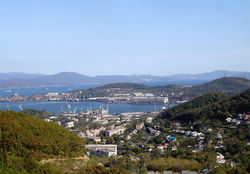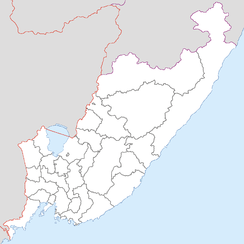Nakhodka
| Nakhodka (English) Находка (Russian) |
|
|---|---|
| — Inhabited locality — | |
 Nakhodka seen from the west |
|
.svg.png) Location of Primorsky Krai in Russia |
|
 Nakhodka
|
|
| Coordinates: | |
.png) |
.png) |
| Holiday | Last Sunday in May |
| Administrative status | |
| Country | Russia |
| Federal subject | Primorsky Krai |
| Municipal status | |
| Urban okrug | Nakhodka Urban Okrug |
| Mayor | Oleg Kolyadin |
| Statistics | |
| Population (2002 Census) | 148,826 inhabitants[1] |
| Time zone | VLAT/VLAST (UTC+10/+11) |
| Founded | 1940 |
| Postal code(s) | 692900–692955 |
| Dialing code(s) | +7 4236 |
| Official website | |
Nakhodka (Russian: Нахо́дка) is a port city in Primorsky Krai, Russia. The city had 148,826 inhabitants as of the 2002 Census, down from 160,056 recorded in the 1989 Census. During the years from 1950 until 1991, when the nearby large port of Vladivostok was closed to foreigners and foreign shipping, Nakhodka became the primary deep water port in the Russian Far East.
Contents |
Geography
Nakhodka is one of the most easterly large cities in Russia, on the Nakhodka Bay of the Sea of Japan, around 9000 km from Moscow and about 85 km east of Vladivostok. The nearest other town is Partizansk, around 50 km to the north.
History
Nakhodka Bay, around which the city is organized, was discovered in 1859 by the Russian corvette "Amerika", which sought shelter in the bay during a storm. In honour of this occasion, the ice-free and relatively calm bay was named Nakhodka, which in Russian means discovery or "lucky find".
Until the 20th century the area around the bay remained uninhabited, with the first settlement a small fishing village founded in 1907. When the Soviet government decided to build a harbour in the area in 1930s, a number of small settlements were founded, which were merged as a work settlement in 1940s. In 1950 the town, now with around 28,000 residents, was given town status.
In the early 1950s, Soviet authorities decided to close Vladivostok to foreign shipping and use it as the base for the Soviet Pacific Fleet. Nakhodka became both the eastern terminus for passenger trains on the Trans-Siberian Railway and only port in the Russian Far East which was open to foreigners, these factors stimulating the town's rapid growth. Many of the buildings in the city date from the 1950s, when Japanese prisoners of war were used as forced-labour to build housing for the incoming port workers. The city's heyday was apparently in the 1970s and 1980s, when it was very well-cared for due to its visibility to foreigners.
Economy and Infrastructure
The city's economy, based mostly around the port and port-related activity such as fish processing and canning, has suffered since 1991 as Vladivostok was opened to foreign activity again. Local industry also took a hit during the 1998 Russian financial crisis. However, Nakhodka has been declared a "Free economic zone", and the governments in both Moscow (federal) and Vladivostok (regional) have seemed interested in opening the city further to foreign investment.
Nakhodka is also an important transport junction where goods from Japan are transferred from ships onto the Russian railway system, including the Trans-Siberian Railway portion of the Eurasian Land Bridge.
Sport
FC Okean Nakhodka is the only professional sport club in the city. It spent the 1992 and 1993 seasons in the Russian Premier League. It is also the home town of Football player Viktor Fayzulin.
International relations
Twin towns — sister cities
Nakhodka has the following sister city relationships:
 Maizuru, Kyoto, Japan - June, 1961 (first USSR-Japan sister cities)
Maizuru, Kyoto, Japan - June, 1961 (first USSR-Japan sister cities) Otaru, Hokkaido, Japan - September 12, 1966
Otaru, Hokkaido, Japan - September 12, 1966 Tsuruga, Fukui, Japan - October, 1982
Tsuruga, Fukui, Japan - October, 1982 Bellingham, Washington, USA - April, 1975
Bellingham, Washington, USA - April, 1975 Oakland, California, USA - April, 1975
Oakland, California, USA - April, 1975 Jilin City, Jilin, China - July, 1991
Jilin City, Jilin, China - July, 1991 Donghae City, South Korea - December, 1991
Donghae City, South Korea - December, 1991 Phuket Province, Thailand - September 21 , 2006.
Phuket Province, Thailand - September 21 , 2006.
Gallery
|
Panorama of Nakhodka bay as seen from Dzerzhinsky Hill. May 2006 |
 The cliffs "Brother" and "Sister" near Nakhodka |
 Nakhodka harbour |
 Nakhodka in summer |
 Shopping center in Nakhodka |
References
- ↑ Федеральная служба государственной статистики (Federal State Statistics Service) (2004-05-21). "Численность населения России, субъектов Российской Федерации в составе федеральных округов, районов, городских поселений, сельских населённых пунктов – районных центров и сельских населённых пунктов с населением 3 тысячи и более человек (Population of Russia, its federal districts, federal subjects, districts, urban localities, rural localities—administrative centers, and rural localities with population of over 3,000)" (in Russian). Всероссийская перепись населения 2002 года (All-Russia Population Census of 2002). Federal State Statistics Service. http://perepis2002.ru/ct/html/TOM_01_04_1.htm. Retrieved 2009-08-19.
External links
- City's Official Site (Russian)
- City website in English
|
|||||||||||||||||
|
|||||||||||